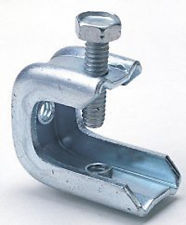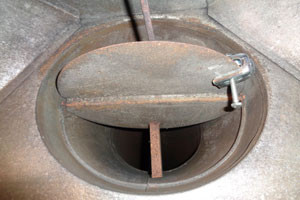 The issue of damper clamps can be confusing, not just to homeowners but to home inspectors, utility companies, government building departments and even amongst chimney professionals. In many cases, this issue rears its ugly head during the stressful time of purchasing or selling a home.
The issue of damper clamps can be confusing, not just to homeowners but to home inspectors, utility companies, government building departments and even amongst chimney professionals. In many cases, this issue rears its ugly head during the stressful time of purchasing or selling a home.
What is a damper clamp?
Damper clamps are also referred to as damper stops, damper locks or damper flue clamps, but the terms are all synonymous. They are typically a small C-clamp or steel beam clamp. The damper clamp is designed to lock the damper in a fully-open position. The damper is the metal plate that closes off the flue pipe. The purpose of the damper is to prevent heat loss from the home.
When is a damper clamp required?

A damper clamp is required by code when artificial gas logs or a log lighter are present in an open fireplace. When gas logs are in use, the fuel (whether natural gas or propane) is going through the combustion process. The by-product from combustion is carbon monoxide, which is a colorless and odorless gas. If the damper is not open, the carbon monoxide cannot be exhausted up and out like it should, but instead will be drawn into the living area in which case the homeowners can get very sick and, in extreme cases, may die.
According to page 234 of the 2016 California Building Energy Efficiency Code for Residential and Non-Residential Building, Sub-Chapter 7/Section 150.0, 1C: ” When a gas log, log lighter, or decorative gas appliance is installed in a fireplace, the flue damper shall be blocked open …”
Why is a damper clamp required with gas logs?
If you’re burning wood in your fireplace and you forget to open the damper, you’re going to know it right away because the room will fill with smoke. If you’re burning gas logs and you forget to open the damper, you could become very sick or, in extreme cases, you can die because the gas loses its odor and is colorless, odorless and toxic and now spilling into the living area. For that reason, code requires the damper is locked in a FULLY-OPEN position so you can’t make that mistake.
Damper clamps are especially critical in the case of rental properties where the fireplace has artificial gas logs or a log lighter. If a tenant forgets to open up the damper and death results, besides the horrific loss of life, the heirs of the tenant will sue the homeowner and/or property management company due to the negligence of not having a damper clamp to lock the damper open.
Can the damper be locked partially open?
Manufacturers’ installation instructions for artificial gas log sets specifically say that dampers must be locked in a “FULLY-OPEN POSITION.” Some professional installers will lock the damper partially closed to reduce the heat loss from the home when the gas logs are not in use as well as to bring more heat into the room when the gas logs are in use. However, a partially-closed damper may restrict the draft enough to cause gas spillage into the living area when the gas logs are on. For that reason, gas log manufacturers specifically state that the dampers be locked fully open. Professional gas log installers may open themselves up to liability if they lock the damper partially closed.
With the damper locked open, how can I prevent heat loss from my home?
When not in use, a fully-open damper is like having an open window all the time and you will lose a great deal of heat from your home. This is a major disadvantage to gas logs or a log lighter. Even if you’re not using the gas logs and you turn on your central heater or furnace, it may actually draw the cold air down the flue and into the room, bringing the cold air in. To prevent heat loss, install glass doors in front of the fireplace. Keep in mind, in the case of prefab fireplaces, glass doors are not always available or listed with the system so glass doors may not always be a viable option for prefab systems.
Be very careful about putting glass doors on prefab fireplaces. You can only put the EXACT glass doors that are SPECIFICALLY designed for that exact manufacturer and exact model of the system. If you put on the wrong glass doors on a prefab fireplace, you will void out the listing on the system and can cause a potentially dangerous situation because the prefab system can overheat during a fire.
Is a damper clamp required with a log lighter used with wood burning?
There is a wide range of opinions on this question and the answer is that a damper clamp is still required with a log lighter. A log lighter is a round pipe under the grate, used to easily start a wood fire. You place the wood on the grate, turn on the gas and after about 10 minutes, turn the gas off. There’s no need for newspaper or kindling and it makes it very easy to start a wood fire. According to the above-stated code, if there is a log lighter present inside the firebox, the damper must be locked fully open. However, if the firebox is plumbed for gas but the gas is capped off, no damper clamp is required.
Having a damper clamp in place with gas logs or a log lighter is frankly a no-brainer, not only for the safety for you, your family members and/or tenants but for your liability as well. The lack of a damper clamp with gas logs or a log lighter WILL also be noted by a home inspector during a home sale. Some local utility companies will “red tag” your system if a damper clamp is not installed. A damper clamp is a critical safety issue when you have artificial gas logs or a log lighter!
One last caveat: Check your local jurisdiction to see what your local codes are for your area. This above-mentioned code is a California Code.
[This blog was updated as of 3/27/18.]

I have an old wood burning fireplace in which I am putting non-vented gas logs. I have not purchased the logs yet as I am still gathering information.
The flue does not have a closing damper. I am planning on blocking the flue using sheet metal and HVAC metal tape. The distance from the logs to the proposed shield is 17.” Will this metal shield be sufficient for this non-vented gas logs application?
Thanks.
Rob,
In answer to your question, it all depends on if you have a prefab fireplace system or a masonry system. If it’s a prefab, you absolutely cannot install anything on the system that would modify the system against the manufacturer’s specifications. If it’s a masonry system, there’s no problem installing what you described. I’m not familiar with what you described because we’re located in San Diego, California where there’s very little need for it. Perhaps you can look online or go to a local fireplace store in your area, they may be able to locate this. Or you could contact a local chimney sweep who will be more familiar with what is available that will work for your system.
Good luck!
Terri Pocock, Owner
Swede Chimney Sweep
San Diego, CA
My wood burning fireplace damper is either wide open or closed how can I regulate the damper to control all the heat from going up the chimney need to heat house, please help
Unfortunately a damper is designed to be either wide open or wide closed. They are not designed to be half open/half closed. To wedge it (somehow) half open during a fire would bring in a bit of heat into the room but would be dangerous because the smoke and gases would also come into the room. Unfortunately open fireplaces like yours are not designed to produce much heat except for a bit of radiant heat.
Any contractor who says they can wedge it halfway is not only irresponsible but is opening themselves up to liability if you or your family gets injured or dies from carbon monoxide poisoning or smoke inhalation. A damper is designed only to be WIDE OPEN when in use. Also, if the damper is wedged halfway, there’s a possibility that it can fall closed on its own during a fire.
Deaths from fireplace dampers being closed does happen. Here’s an article about singer Weird Al Yankovic’s parents who died from carbon monoxide poisoning due to their fireplace damper being closed.
http://articles.latimes.com/2004/apr/11/local/me-weirdal11
Your only other option would be a stove insert. Those produce an incredible amount of heat, actually BLOWING the heat into the room. Stove inserts are also extremely efficient, using much less wood for more BTU’s of heat. Stove inserts come in wood burning or gas burning or pellet burning. The down sides to stove inserts are #1) They can be expensive and 2) They can ONLY be installed in brick and mortar masonry fireplaces and NEVER into pre-fab fireplaces.
As an example, here is a link to Regency’s website. They are a popular brand of stove inserts. In fact, I have this stove insert in my own fireplace. https://www.regency-fire.com/en/Products/Wood/Wood-Inserts
I’m so sorry that I can’t give you the answer that you want. Hopefully I have provided an option that will prevent the heat loss and produce more heat.
Terri Pocock, Owner
Swede Chimney Sweep
San Diego, CA
Thank you so much for the great article, it was fluent and to the point. Cheers.
just installed vent free gas logs in my wood buring fireplace. Trying to use it for heating
one room in cold weather, and ambiance other times. Concerned about odor and potential air quality issues. So what if I installed a clamp on my flue to keep it partially open? Is this possible, or not. thankyou.
I’m not sure which state you’re in. California, where we are located, does not allow vent-free gas logs and for very good reason.
They can emit byproducts such as carbon monoxide and condensation. They can also produce a burning gas odor. You are right in being concerned about the odor and air quality issues in your home. Where this becomes an even bigger issue is when these vent-free gas logs are in a bedroom fireplace, something we never recommend because you just may never wake up.
Here in California, when you have gas logs in a fireplace, the damper has to be locked FULLY OPEN. The manufacturers of the regular gas logs also say that the damper has to be locked in a FULLY OPEN position.
You will need to check your state as well as local city and municipality codes to determine if vent-free gas logs are even allowed where you live. Regardless of the code requirements, my professional opinion is that you should have a damper clamp to lock the damper in a fully open position even if the manufacturer says the logs are vent free.
Your life is just too important.